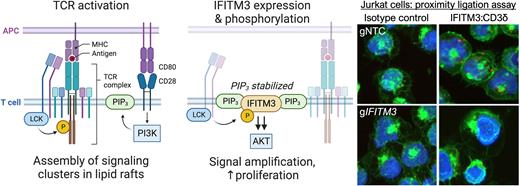Abstract
Background: Phosphatidylinositol 3-kinase (PI3K) signaling is an indispensable element of T-cell receptor (TCR), co-stimulatory receptor, and cytokine receptor activation in T cells and in the oncogenic signaling underlying T-cell malignancies. We recently identified interferon-inducible transmembrane protein 3 (IFITM3) as an unexpected but essential component of antigen receptor signaling and malignant transformation in B cells. In contrast to its previously characterized role as an interferon-stimulated gene which restricts viral entry through endosomal membranes, IFITM3 also directly binds to the lipid PIP3 - the product of PI3K - at the B cell surface and amplifies PI3K-mediated signal transduction. Whether IFITM3 serves an analogous function in other lymphocytes is currently unknown. Here, we demonstrate that IFITM3 is also required for robust PI3K-driven signaling and proliferation in primary and transformed human T cells.
Results: We found that resting primary human T cells express low levels of IFITM3 but robustly upregulate IFITM3 protein following CD3/CD28 stimulation. To test whether IFITM3 participates in TCR signaling, we analyzed IFITM3 and PIP3 subcellular localization in Jurkat cells. Proximity ligation assays revealed that IFITM3 co-localizes with CD3δ at the cell surface, indicating recruitment of IFITM3 to TCR signaling complexes. Moreover, in the absence of IFITM3, a fluorescent reporter of PIP3 localization failed to redistribute from a diffuse cytosolic pattern to discrete foci at the cell surface upon TCR stimulation. We further explored whether these aberrant PIP3 dynamics were associated with broader defects in PIP3-dependent signaling axes important in T cells. In accord with prior findings in B cells, both Jurkat and primary T cells lacking IFITM3 expression exhibited diminished TCR signaling, including Ca2+ flux and PI3K-dependent AKT phosphorylation, and impaired cell proliferation relative to controls. These results demonstrate that T cells require IFITM3 for optimal antigen receptor- and PI3K-driven signaling.
Mechanistically, IFITM3 is phosphorylated by Src family kinases at Y20, promoting retention at the plasma membrane, and specifically binds to PIP3, a highly negatively charged phospholipid, through basic residues in its conserved intracellular loop (CIL). We assessed the functional relevance of these residues in T cells by comparing the effects of wild-type and mutant IFITM3 variants. Overexpression of wild-type IFITM3 or a mutant with constitutive plasma membrane localization (Y20E) increased TCR-induced AKT phosphorylation, but a CIL mutant incapable of binding to PIP3 (K83A/K104A) lacked this activity and instead compromised cell viability and growth. Primary T cells expressing CIL-mutant IFITM3 were more apoptotic and demonstrated impaired cell cycle progression and proliferation, highlighting PIP3 binding as an essential feature of IFITM3 in T cell biology.
Beyond normal T cells, PI3K signaling also enables the transformation of malignant T cells, with PI3K inhibitors emerging as promising agents in the treatment of peripheral T cell lymphomas (PTCLs). To determine whether IFITM3 contributes to the oncogenic signaling in PTCLs, we developed disease models incorporating both the expression of PTCL-derived oncogenes in T cells and the capability to assess candidate genes as functional players in pathogenesis. In a mouse bone marrow chimera system, conditional expression (via CD4-Cre) of a lentivirus-delivered oncogene (e.g., ITK-SYK) gave rise to circulating transgenic donor T cells and oncogene-dependent morbidity and mortality. In a humanized mouse system, a T cell-specific promoter controlled transgene expression upon transduction of CD34+ cord blood progenitors. In a separate approach, transduction of mature human T cells differentiated in vitro from CD34+ cells permitted a constitutive promoter. These results establish tractable systems to assess IFITM3 as a requisite factor for oncogenic signaling in PTCLs.
Conclusion: We conclude that IFITM3 is essential for antigen receptor and oncogenic signaling not only in B cells but also in T cells. These findings identify a novel component of TCR signaling and suggest a shared mechanism for lymphocyte dependency on IFITM3 through scaffolding the lipid PIP3, a mechanism which can be leveraged to amplify oncogenic signaling in T cell malignancies.
Disclosures
No relevant conflicts of interest to declare.
Author notes
Asterisk with author names denotes non-ASH members.


This feature is available to Subscribers Only
Sign In or Create an Account Close Modal